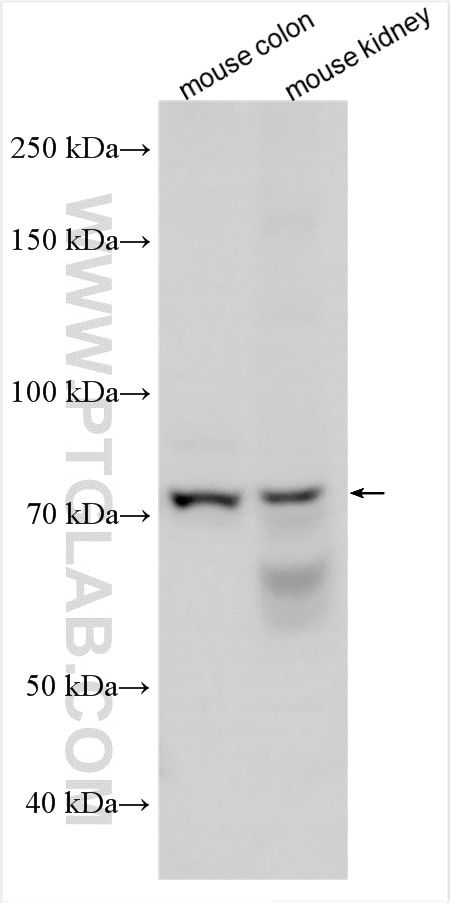SGLT1 Polyklonaler Antikörper
SGLT1 Polyklonal Antikörper für WB, ELISA
Wirt / Isotyp
Kaninchen / IgG
Getestete Reaktivität
human, Maus
Anwendung
WB, ELISA
Konjugation
Unkonjugiert
Kat-Nr. : 30861-1-AP
Synonyme
Galerie der Validierungsdaten
Geprüfte Anwendungen
| Erfolgreiche Detektion in WB | Maus-Kolongewebe, Mausnierengewebe |
Empfohlene Verdünnung
| Anwendung | Verdünnung |
|---|---|
| Western Blot (WB) | WB : 1:500-1:1000 |
| It is recommended that this reagent should be titrated in each testing system to obtain optimal results. | |
| Sample-dependent, check data in validation data gallery | |
Produktinformation
30861-1-AP bindet in WB, ELISA SGLT1 und zeigt Reaktivität mit human, Maus
| Getestete Reaktivität | human, Maus |
| Wirt / Isotyp | Kaninchen / IgG |
| Klonalität | Polyklonal |
| Typ | Antikörper |
| Immunogen | SGLT1 fusion protein Ag29338 |
| Vollständiger Name | solute carrier family 5 (sodium/glucose cotransporter), member 1 |
| Berechnetes Molekulargewicht | 73 kDa |
| Beobachtetes Molekulargewicht | 73 kDa |
| GenBank-Zugangsnummer | NM_000343 |
| Gene symbol | SLC5A1 |
| Gene ID (NCBI) | 6523 |
| Konjugation | Unkonjugiert |
| Form | Liquid |
| Reinigungsmethode | Antigen-Affinitätsreinigung |
| Lagerungspuffer | PBS mit 0.02% Natriumazid und 50% Glycerin pH 7.3. |
| Lagerungsbedingungen | Bei -20°C lagern. Nach dem Versand ein Jahr lang stabil Aliquotieren ist bei -20oC Lagerung nicht notwendig. 20ul Größen enthalten 0,1% BSA. |
Hintergrundinformationen
SLC5A1, also known as SGLT1, is a sodium-dependent glucose transporter (SGLT) family member. SGLT1 couples sugar transport to Na+ gradients across the intestinal brush border (PMID: 8563765). SGLT1 mediates active glucose and galactose absorption in the intestine and renal glucose scavenging. Mutations in SGLT1 cause glucose-galactose malabsorption (GGM) syndrome (PMID: 34880492). SGLT1 is expressed in intestine and endometrial cells (PMID: 2490366, 28974690).
Protokolle
| Produktspezifische Protokolle | |
|---|---|
| WB protocol for SGLT1 antibody 30861-1-AP | Protokoll herunterladen |
| Standard-Protokolle | |
|---|---|
| Klicken Sie hier, um unsere Standardprotokolle anzuzeigen |


